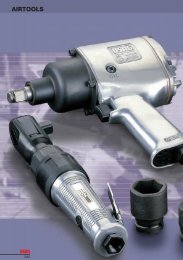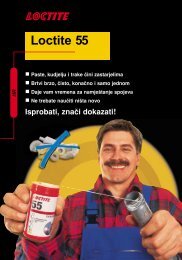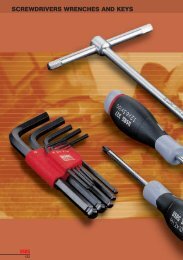Industrial seal self study guide - SKF.com
Industrial seal self study guide - SKF.com
Industrial seal self study guide - SKF.com
Create successful ePaper yourself
Turn your PDF publications into a flip-book with our unique Google optimized e-Paper software.
SEAL DESIGN GROUPS (cont.)<br />
HDSB<br />
HDSB <strong>seal</strong> has both a spring-loaded<br />
and non-spring loaded lip (fig. 3n).<br />
HDSB<br />
HDSB is similar to HDSA in that it also has a non-spring loaded<br />
auxiliary lip <strong>com</strong>bined with a spring-loaded lip (fig. 3n). The chamfer<br />
on the auxiliary lip of the HDSB faces away from the spring-loaded<br />
lip, permitting easier shaft insertion from the back. This eliminates<br />
the need to reverse the direction of the auxiliary lip when the shaft<br />
enters the <strong>seal</strong>. However, HDSB may be less effective in contaminant<br />
exclusion due to the direction of the auxiliary <strong>seal</strong>ing element.<br />
Two designs are available. HDSB1 and HDSB2 both have<br />
Spring-Lock, while HDSB2 also has Spring-Kover.<br />
HDSC<br />
For maximum exclusion of<br />
contaminants, HDCS <strong>seal</strong> has an<br />
auxiliary lip on the spring side of<br />
the spring-loaded lip (fig. 3o).<br />
HDSD<br />
For separating two fluids, HDSD<br />
has opposing <strong>seal</strong>ing elements in<br />
a single shell (fig. 3p)<br />
HDSE<br />
Where back-up <strong>seal</strong>ing action<br />
is desired, HDSE’s two <strong>seal</strong>ing<br />
elements serve as two <strong>seal</strong>s in<br />
one (fig. 3q).<br />
HDSC<br />
HDSC (fig. 3o) is similar to HDSA, but with one exception. The auxiliary<br />
lip is placed on the spring side of the spring-loaded lip and faces the<br />
same direction, providing maximum exclusion of foreign materials.<br />
This style is re<strong>com</strong>mended when excluding foreign materials is more<br />
important than retaining lubricants. When HDSC is installed, both<br />
<strong>seal</strong>ing elements point toward the material being excluded. HDSC<br />
should not be used in oil lubricated systems.<br />
HDSD<br />
Type HDSD has two opposing <strong>seal</strong>ing elements in a single shell<br />
(fig. 3p). That makes this design ideal for separating two fluids in<br />
applications where two individual <strong>seal</strong>s are impractical. Both <strong>seal</strong>ing<br />
lips in HDSD1 have Spring-Lock, while each <strong>seal</strong>ing lip in HDSD2 has<br />
Spring-Lock and Spring-Kover. HDSD can also be used to retain and<br />
exclude.<br />
There must be ample lubrication between the two <strong>seal</strong>ing elements.<br />
Pack the cavity between the lips with grease, or optional drill lube holes<br />
from the O.D. to the I.D. for lubrication for <strong>seal</strong>ing elements can be<br />
provided by <strong>SKF</strong>.<br />
HDSE<br />
HDSE has two <strong>seal</strong>ing elements with both lips facing in the same<br />
direction (fig. 3q). This design is re<strong>com</strong>mended in applications where a<br />
back-up <strong>seal</strong> is desired for retention or exclusion, but there is no room<br />
for two <strong>seal</strong>s. HDSE1 features Spring-Lock on both lips, while HDSE2<br />
features both Spring-Lock and Spring-Kover. If installed to exclude,<br />
grease lubrication should be used for the bearings.<br />
Lubricating the back-up lip is very important, since it could easily run<br />
dry. The primary lip usually stays well lubricated from the fluid being<br />
retained. <strong>SKF</strong> can provide HDSE with pre-drilled lube holes on the O.D.<br />
18







